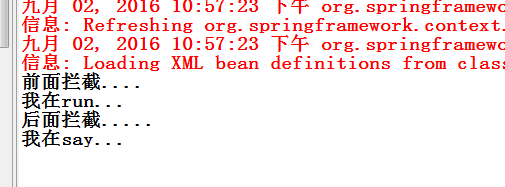【框架】[Spring]AOP攔截-三種方式實現自動代理
這裡的自動代理,我講的是自動代理bean物件,其實就是在xml中讓我們不用配置代理工廠,也就是不用配置class為org.springframework.aop.framework.ProxyFactoryBean的bean。
總結了一下自己目前所學的知識。
發現有三種方式實現自動代理
用Spring一個自動代理類DefaultAdvisorAutoProxyCreator:
<bean class="org.springframework.aop.framework.autoproxy.DefaultAdvisorAutoProxyCreator"></bean 例如:
原來不用自動代理的配置檔案如下:
<?xml version="1.0" encoding="UTF-8"?>
<beans xmlns="http://www.springframework.org/schema/beans"
xmlns:xsi="http://www.w3.org/2001/XMLSchema-instance" xmlns:context="http://www.springframework.org/schema/context"
xmlns:tx="http://www.springframework.org/schema/tx"
xsi:schemaLocation 現在改用自動代理,如下配置:
<beans ...>
<!-- 代理前原物件 -->
<bean id="person" class="cn.hncu.xmlImpl.Person"></bean>
<!-- 切面 = 切點+通知 -->
<bean id="advisor" class="org.springframework.aop.support.RegexpMethodPointcutAdvisor">
<!-- 切點 -->
<property name="patterns">
<list>
<value>.*run.*</value>
</list>
</property>
<!-- 通知-由我們寫,實際代理動作 -->
<property name="advice">
<bean id="advice" class="cn.hncu.xmlImpl.AroundAdvice"></bean>
</property>
</bean>
<!-- 自動代理 -->
<bean class="org.springframework.aop.framework.autoproxy.DefaultAdvisorAutoProxyCreator"></bean>
</beans>測試方法
@Test//自動代理
public void demo4(){
ApplicationContext ctx = new ClassPathXmlApplicationContext("cn/hncu/xmlImpl/4.xml");
//我們直接在這裡獲取Person物件就可以了,因為在最開始xml檔案newPerson物件後,Spring就已經幫我們代理了!
Person p =ctx.getBean(Person.class);
p.run();
p.say();
}相對於前面,也就是把代理工廠部分換成自動代理了。
演示結果:
自己寫一個自動代理底層實現:
我們也可以寫一個類,來實現DefaultAdvisorAutoProxyCreator自動代理的功能!
首先,我們需要實現一個介面,也就是BeanPostProcessor介面。
BeanPostProcessor介面作用是:如果我們需要在Spring容器完成Bean的例項化、配置和其他的初始化前後新增一些自己的邏輯處理,我們就可以定義一個或者多個BeanPostProcessor介面的實現,然後註冊到容器中。
而我們想要在原型物件bean被建立之後就代理了,就必須在原來的容器中拿到原來的原型物件,需要拿到原來spring容器中的切面物件,這個時候,我們就需要原來的容器,這個時候就需要另一個介面,也就是ApplicationContextAware介面!
通過這2個介面,我們就可以實現自動代理了。
package cn.hncu.xmlImpl;
import org.springframework.aop.Advisor;
import org.springframework.aop.framework.ProxyFactoryBean;
import org.springframework.beans.BeansException;
import org.springframework.beans.factory.config.BeanPostProcessor;
import org.springframework.context.ApplicationContext;
import org.springframework.context.ApplicationContextAware;
public class MyAutoProxy implements BeanPostProcessor,ApplicationContextAware{
private ApplicationContext applicationContext=null;
//bean建立之前呼叫
@Override
public Object postProcessBeforeInitialization(Object bean, String beanName)
throws BeansException {
return bean;//在這裡,我們直接放行
}
//bean建立之後呼叫
@Override
public Object postProcessAfterInitialization(Object bean, String beanName)
throws BeansException {
ProxyFactoryBean factory = new ProxyFactoryBean();
//把原型物件放入代理工廠
factory.setTarget(bean);
//在這裡
Advisor adv = applicationContext.getBean(Advisor.class);
factory.addAdvisor(adv);
//返回被代理後的物件
return factory.getObject();
}
//拿到原來的spring中的容器
@Override
public void setApplicationContext(ApplicationContext applicationContext)
throws BeansException {
this.applicationContext=applicationContext;
}
}
5.xml
<beans...>
<!-- 代理前原物件 -->
<bean id="person" class="cn.hncu.xmlImpl.Person"></bean>
<!-- 切面 = 切點+通知 -->
<bean id="advisor" class="org.springframework.aop.support.RegexpMethodPointcutAdvisor">
<!-- 切點 -->
<property name="patterns">
<list>
<value>.*run.*</value>
</list>
</property>
<!-- 通知-由我們寫,實際代理動作 -->
<property name="advice">
<bean id="advice" class="cn.hncu.xmlImpl.AroundAdvice"></bean>
</property>
</bean>
<!-- 自己寫的自動代理 -->
<bean class="cn.hncu.xmlImpl.MyAutoProxy"></bean>
</beans>測試方法:
@Test//自己實現的自動代理
public void demo5(){
ApplicationContext ctx = new ClassPathXmlApplicationContext("cn/hncu/xmlImpl/5.xml");
Person p =ctx.getBean(Person.class);
p.run();
p.say();
}測試結果就不上圖了,和前面是一樣的。
其實很多時候,我們如果自己去練一下底層,對上層的框架更好理解。
還有一種方法。
使用aop標籤配自動代理
需要在beans加一個名稱空間
xmlns:aop="http://www.springframework.org/schema/aop"還需要配xsi:schemaLocation,為aop加一個網路地址。
http://www.springframework.org/schema/aop http://www.springframework.org/schema/aop/spring-aop-4.3.xsdxml配置檔案:
<?xml version="1.0" encoding="UTF-8"?>
<beans xmlns="http://www.springframework.org/schema/beans"
xmlns:xsi="http://www.w3.org/2001/XMLSchema-instance"
xmlns:context="http://www.springframework.org/schema/context"
xmlns:tx="http://www.springframework.org/schema/tx"
xmlns:aop="http://www.springframework.org/schema/aop"
xsi:schemaLocation="http://www.springframework.org/schema/beans http://www.springframework.org/schema/beans/spring-beans-4.3.xsd
http://www.springframework.org/schema/context http://www.springframework.org/schema/context/spring-context-4.3.xsd
http://www.springframework.org/schema/tx http://www.springframework.org/schema/tx/spring-tx-4.3.xsd
http://www.springframework.org/schema/aop http://www.springframework.org/schema/aop/spring-aop-4.3.xsd ">
<!-- 利用sop標籤實現自動代理 -->
<aop:aspectj-autoproxy></aop:aspectj-autoproxy>
<!-- 代理前原物件 -->
<bean id="person" class="cn.hncu.xmlImpl.Person"></bean>
<!-- 切面 = 切點+通知 -->
<bean id="advisor" class="org.springframework.aop.support.RegexpMethodPointcutAdvisor">
<!-- 切點 -->
<property name="patterns">
<list>
<value>.*run.*</value>
</list>
</property>
<!-- 通知-由我們寫,實際代理動作 -->
<property name="advice">
<bean id="advice" class="cn.hncu.xmlImpl.AroundAdvice"></bean>
</property>
</bean>
</beans>測試方法:
@Test//自動代理
public void demo6(){
ApplicationContext ctx = new ClassPathXmlApplicationContext("cn/hncu/xmlImpl/6.xml");
Person p =ctx.getBean(Person.class);
p.run();
p.say();
}測試結果:
個人覺得能學會使用一種就OK了,不用全部記下來,為了學習,都瞭解一下就好,別人寫出來,能看懂就好。
哈哈,其實底層學好了,自己寫的時候,就算不會用Spring的自動代理,自己寫出來底層也是蠻好的嘛
本文章由[諳憶]編寫, 所有權利保留。


